Final report for ONC20-069
Project Information
Final Project Summary
The Kickapoo River Watershed (KRW) region in SW Wisconsin is experiencing significant loss of livestock integration and thus grass cover. From 1997-2012, the counties in the KRW lost around 18% of their pastureland and a staggering amount of dairy farms, burdening the economic vibrancy and ecological resiliency of this community. Decreased grass cover is associated with increased nutrient loss to waterways, reduced biodiversity, and poor flood control (Atwell et al., 2010). Almost 45% of the KRW’s subwatersheds are in the top 20% of Wisconsin HUC12 watersheds for water quality sensitivity to agricultural BMPs (WBI, 2005).
Valley Stewardship Network (VSN) is a KRW non-profit with 23-years experience in water quality research along with 7-years experience in watershed council development and working lands conservation. VSN partners with farmers to measure impacts of BMP’s; supports watershed councils; and with this project as a first step, is working toward the coordination of an on-farm stewardship research group.
To increase grass cover for improved water quality, flood control and ecological resiliency, this on-farm research/education project focused on benefits of reintegrating forages and native grasses on mid-sized diversified crop and livestock farms. From 2020-2023, four components were explored and research and demonstration conclusions and farmer adoption actions are listed with each.
Component 1: Demonstrate cover cropping and native prairie strips for soil quality, increasing water infiltration and grazing. 1-acre native prairie STRIP was planted on marginal ground in 2020 and mowed several times and 7-acres of cover crops were planted and grazed in 2021. Water infiltration test was 2.5x higher in grassed waterway than adjacent soybeans.This component was limited due to covid-related challenges.
Component 2: Demonstrate cover cropping seeding techniques, equipment, management, and grazing. Project cooperators mounted VSN air seeder on rotary hoe to be available for cover crop inter-seeding into V5 or earlier corn. Cover crops planted for grazing and field day held in 2020. In 2021, 20-acres of red clover drone-seeded and two field days held. In 2022, red clover was inter-seeded on 5.5 acres. A key take away from this project is the need to fine tune the chemical and fertilizer systems to better support the use of creative cover crop usage in our specific geographic and temperate area. On-farm experiments can provide valuable information to improve our farming practices whether it’s to improve our environmental footprint, or enhance profitability. We need to be manageable in size, but relatable in practice and practicality of real time and localized farming practices. As a result of the demonstrations and field days, more than 50 farmers and 10 agricultural professionals increased their knowledge of cover cropping benefits in our region.
Component 3: Research and demonstrate verification standards, with bird surveys, for bird-friendly grazing and hay production, including haying management and nest refuge paddock guidelines for rotational grazing systems. Verification standards and economic impact were researched, established and tested for bird-friendly grazing and hay production. Bird survey point counts at five locations (two in rotational grazing, one in grazing refuge, one in late-cut hay, and one in conventional hay) were completed weekly for 8-weeks in Summer 2020 and 2021. Results showed successful grassland bird breeding in the grazing refuge and late-cut hay with minimal economic cost to farmer. Covering those costs with value-added, bird-friendly beef and hay is possible. Market research and outreach is on-going and included a November 2020 Bird Friendly meal collaboration with a local caterer and community outreach. A website was also developed: https://birdfriendlyfarming.org/ After outreach and a field day, four additional producers are beginning to adopt these practices.
Component 4: Increase prairie filter strip planting and research and demonstrate the infiltration, soil quality and biodiversity benefits of adapting the ISU prairie STRIPS adjacent to row crop fields in SW Wisconsin.
Seeding 5 acres, along with maintenance, and seed harvest were implemented on the demonstration and neighboring farm, along with water infiltration, soil quality, and pollinator data collection. The data does demonstrate that the STRIPs are increasing their ability to infiltrate water, and that it is significantly better than in the adjacent corn field. This is supported by the impacts observed in the field. The original driver for these STRIPs were to reduce erosion in the field bottom caused by rapid rain runoff, and this is erosion is no longer happening with mature STRIPS in place. Pollinator habitat also increased in the STRIPS. Field days and tours on the demonstration farm along with 41 outreach visits were completed. This project allowed us to develop customized seed mixes and increase the number of acres we have planted with STRIPS from 15 in 2019 to 54 at the end of 2022, as well as increase number of sub-watersheds where we have STRIPS planted from 6 to 10.
Overall: Create an on-going structure for on-farm stewardship research with motivated farmer leaders in priority sub-watersheds.
Component 1: Demonstrate cover cropping and native prairie strips for soil quality, increasing water infiltration and grazing.
Component 2: Demonstrate cover cropping seeding techniques, equipment, management, and grazing.
Component 3: Test and establish verification standards and economic impact for bird-friendly grazing and hay production, including haying management and nest refuge paddock guidelines for rotational grazing systems.
Component 4: Increase prairie strip plantings and demonstrate the infiltration, soil quality and biodiversity benefits of prairie filter strips adjacent to row crop fields.
Cooperators
- (Educator and Researcher)
- (Educator and Researcher)
- (Educator and Researcher)
- (Educator and Researcher)
- (Educator and Researcher)
- (Educator)
- (Educator and Researcher)
- (Educator and Researcher)
Research
COMPONENT ONE : COVER CROPS AND PRAIRIE STRIPS FOR SOIL QUALITY AND GRAZING
Jeremy Nagel Farm, Soldiers Grove, WI
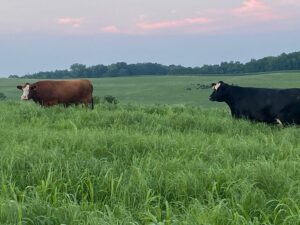
Demonstration of cover crop seeding, grazing and management. Establishment and assessment of prairie strip soil benefits.
Cover Crop Establishment and Grazing
Jeremy Nagel planted 7-acres of a brassica, clover, and warm season mix as an annual in early June 2021. Directly following the planting there were two weeks of dry weather resulting in only minimal growth in the early season. He was able to graze it for two days in mid-July, followed by 30 days rest. Then grazed it for a week in mid-August. He applied a herbicide late season to kill off the clover, as the following spring (2022) as he planned to rotate the field into corn. Marginal crop ground was converted to native prairie strip to reduce nutrient and sediment loss.
Soil Nutrient Assessment
Soil sampling was completed in 2020 by VSN staff. Each site utilized Haney and UW lab analysis. These tests should be repeated when feasible in the future to determine soil quality benefits of cover crops and prairie strips.
Prairie Strip Establishment
Working with the Nagels, VSN staff developed an area to be planted with a grazable native prairie strip using a mix we have designed to specifically allow for warm season grazing. 1 acre was planted by VSN staff in November 2020. Nagels maintain the strip with mowing.
Water infiltration rates improve through native plantings, and data was taken by VSN staff in August 2020 in soybeans and in a grassed waterway for ra related comparison on the Nagel farm.
COMPONENT TWO: COVER CROP SEEDING, MANAGEMENT AND GRAZING
Brad Robson Farm, Viroqua, WI
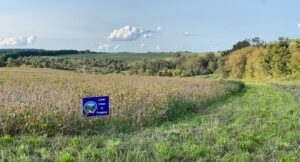
Demonstration of cover crop seeding, management and grazing.
Equipment Development/Use/Lease
Through coordination with the Township of Franklin (Vernon County), VSN was able to procure a Yetter 15’ Rotary hoe. This hoe is the implement used to mount the Gandy 6212 Orbit Air Seeder. Thanks to the township, they offered their services and expertise to engineer and attach the Air Seeder to the rotary hoe for functional inter-seeding. The seeding can occur into row crops, ideally until leaf stage V5 or in the early fall months after row crop harvest. In 2021 the seeder was utilized to do some experimental rye inter-seeding, as well as continue to calibrate for seed types. The seeder is available for a low-cost rental fee to all area farmers.
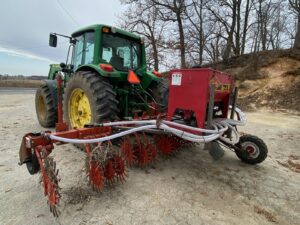
Cover Crop Establishment 2021
On July 23, 2021 a drone inter-seeded red clover into 20 acres of soybeans. The clover germinated quickly and grew for about 2 weeks before terminating. We speculated that the termination was due to residual chemicals in the field. The chemical program is depicted below. We will repeat this process again in 2022, with an alternative chemical program, also into standing beans with the intention to fix nitrogen for the following year's corn crop, which will be tested through corn tissue sampling.
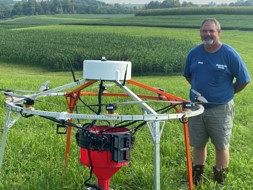
Spray Program:
5-10-21 First pass
Bucaneer + 1 quart
Sonic 4 oz.
2-4-D 1 pint
$26/acre application paid by farmer
6-25-21 Second pass
Bucaneer + 1 quart
Dual 1 pint
Enlist(24D) 1 pint
QLF Boost 2 gal.
CX-1 Biological 2 gal.
$45.80/ acre application paid by farmer
Cover Crop Establishment 2022
The 2022 project was a follow up from the 2021 project trying to increase diversity and “grow” more available nitrogen for the corn crop following a soybean crop.
Soybeans were planted in both 15” and 30” row spacing to learn if there would be any better establishment based on spacing, when inter-seeding a legume plant during the soybean growing season. Red Clover was inter-seeded at a rate of 10 lbs./acre into the growing soybean crop at V2 growth stage to try to get establishment before crop canopy occurred.
Red Clover was chosen as it overwinters and would have very good growth in the following spring before termination in the corn crop. With early planting into soybeans and growth into the corn year, we predicted that the clover should nodulate and fix nitrogen to a level it would reduce synthetic nitrogen input requirements.
In the spring of 2023, the corn would be planted green to allow the clover to grow as late and tall as possible to build biomass and a ground cover mat for weed suppression, nutrient management and erosion control. Unfortunately, due to some weed issues the soybean crop had to be resprayed which in turn eliminated the red clover stand.
Cost:
Red Clover was seeded at 10 lbs. per acre at a cost of $2.80/lb.
Seeding was done with spinner spreader on ATV at a cost of $10/acre
Total area seeded was 5.5 acres
Seed cost $154
Application $55
Total $209
COMPONENT THREE: BIRD FRIENDLY HAYING AND GRAZING
Jim Munsch, Deer Run Farm, Coon Valley, WI
Jason Vidas, Bird Friendly Wisconsin, La Farge, WI (VSN Consultant)
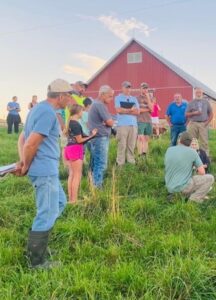
Test and establish verification standards and economic impacts for bird-friendly grazing and hay production, including haying and grazing management, bird surveys and nest refuge paddock guidelines.
Verification Standards and Bird Surveys
Verification standards were researched, established and tested for bird-friendly grazing and hay production. Bird survey point counts at five locations (two in rotational grazing, one in grazing refuge, one in late-cut hay, and one in conventional hay) were completed weekly for eight weeks in Summer 2020 and 2021. Market research and outreach included a November 2020 Bird Friendly meal collaboration with a local caterer and community outreach. A website was also developed: https://birdfriendlyfarming.org/
OVERVIEW
In 2020, in order to refine and better understand the challenges to creating a Bird-Friendly Beef certification protocol that is both farmer-friendly (economically viable) as well as beneficial for grassland bird breeding populations, we had the following goals:
- Divide the grazing and hay ground into different treatments and study how the grassland birds utilized these different treatments throughout the breeding season.
- Quantify the economic costs of setting aside breeding refuge in managed grazing pastures
- Quantify the economic costs of Late Cut Hay (cut after July 15) and quantify the nutritional content of late-cut hay.
Research Methods:
- Divide his hay ground into two treatments - 1)Hay harvested on conventional schedule and 2)Hay harvested on "bird-friendly" schedule of no cutting till after July 15th. Bird Surveys were completed on both treatments throughout the breeding season and we also did a nutritional analysis of the hay from both treatments and attempted to quantify the economic costs of the bird-friendly schedule
- Divide the grazing ground into two treatments - 1)conventional rotationally grazed land that is rotated approximately every X day and 2) grazing ground that is kept as breeding bird refuge (no grazing or mechanical intrusion) from May 1 - July 15th. The "refuge" made up approximately nine acres. Bird surveys were completed on both treatments throughout the breeding season and we also quantified the economic costs to the farmer of creating a breeding refuge.
Bird surveys were done as point counts of 10 minutes each with diameter of 100 meters. A total of eight surveys were completed between June 6 - July 23rd. . Three of these locations were conventional rotationally-grazed pastures, one was breeding refuge, one was conventional hay, and one was bird-friendly hay field. We also did some territorial mapping on the breeding refuge to better understand how this was utilized.
Financial analysis both late-cut hay and grazing refuge.
Hay nutrition compare and contrast.
COMPONENT FOUR: PRAIRIE STRIPS FOR SOIL QUALITY AND BIODIVERSITY
Dave Van Dyke Farm, Viroqua, WI
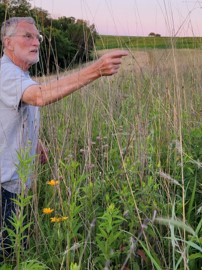
Prairie strip seed mix customizing, planting and seed harvest, water infiltration, soil health and biodiversity (pollinator) data collected to demonstrate the effectiveness of the adaption of the Iowa State University STRIPS model to SW Wisconsin.
Prairie STRIP Establishment
VSN staff planted 1.6 acres of STRIPS on Dave Van Dyke and his neighbor’s property in 2020, to add to the 3 acres of STRIPS planted in 2018 on his property. VSN staff worked with Shooting Star seeds to modify the mix from that previously used on his property to meet farmer goals. 1.5 additional acres were planted on the Van Dyke farm in 2021 and 2022. Also, in fall of 2022 seed was harvested from the 2018 strip to use in late fall 2022 and spring 2023 plantings. Plantings were designed based on the Iowa State University STRIPS (Science-Based Trials of Rowcrops Integrated with Prairie Strips). https://www.nrem.iastate.edu/research/STRIPS/
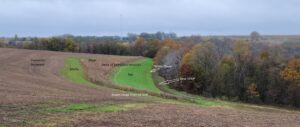
Seed Mix Developed
VSN staff worked with prairie expert, Dr. John Delaney and Shooting Star Native Seeds to understand seed mixes that we have been using developed by John versus standard mixes available. We developed a new tall grass native mix that is $250/acre (compared to $640/acre for our current premium tall grass mix). It has more seeds per square foot, and 21 vs 27 forbs, but still has 30 species (compared to 3-17 species and 30 seeds/ft2 for more traditional mixes). This allows us to implement native seed tall grass plantings much more economically.
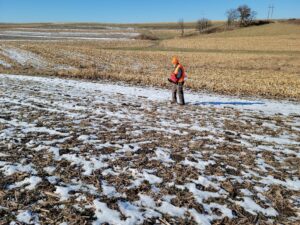
Soil and Water Data
We have also gathered data on water infiltration and soil health on STRIPS vs row-crops in the same field area. We have taken data in July 2018, August 2020 and August 2022, trying to gather data in roughly the same area of the STRIP and the upslope corn field (only 50 feet away so generally the same soil type).
Water Infiltration Test
VSN staff conducted water infiltration tests at Dave Van Dyke’s established prairie STRIP (two locations) (in corn field and STRIP).
Soil Quality Assessment
VSN staff conducted soil sampling at Dave Van Dyke’s farm (three locations, second sampling with previous data from 2018 at same sites). Soil samples were sent to Midwest Labs for the Haney Test and to the UW labs for a traditional soil test on the same grab samples.
This data shows two sample sites in the STRIP in August 2020 (blue and orange, two sites were chosen because the site is sloped and we wanted to see if the slope significantly impacted our infiltration measurement); corn on that same data; and the STRIP again in 2022. Corn data was taken in 2022 as well, but was dramatically inconsistent, enough to say there must have been a problem with the sampling. It was too late in the season by the time this was realized to re-sample the corn in 2022.
The data does demonstrate that the STRIP is increasing its ability to infiltrate water, and that it is significantly better than the adjacent corn field. This is supported by the impacts observed in the field. The original driver for this STRIP was to reduce erosion in the field bottom caused by rapid rain runoff, and this is erosion is no longer happening with the mature STRIP in place.
Pollinator Survey
A pollinator survey was also conducted in the prairie STRIP at Van Dykes in September 2020, which showed 13 insect groups and 50 individuals. We also noted floral associations, which insect types were on which blooming plant.
Overall STRIPS Summary
The SARE project allowed us to increase the number of acres we have planted with STRIPS from 15 in 2019 to 54 at the end of 2022.
The SARE project allowed us to increase number of watersheds where we have STRIPS planted from 6 to 10.
From 2018 to 2022 we visited 61 landowners to see if STRIPS would fit their objectives for their land. Of those, we planted on 19 of those properties with 30 different fields. Of the 30 different fields, 18 of those were during the SARE grant period. The success of those plantings living is between 60-90%, depending on how well some just-planted STRIPS turn out (tentatively all of the recent fields look good). SARE funding through the grant period allowed us to make 55 of the 61 visits!
Of those 61 visits, most were recreational landowners, but the percentage of STRIPS being planted is higher on the farms visited.
We have increased our ability to plant more acres through the donation of a cultipacker to VSN from Dave Van Dyke; and the use of a UTV, trailer and disc from Tom Lukens. This is noted by our average acreage increasing from 2 to 6-acres in the last three years. The cultipacker also increases the germination rate and the likelihood of a successful STRIP installation by gently increasing the seed-to-soil contact without burying the seed.
We are working with two landowners on organic preparation methods to avoid the use of herbicides in seed bed preparation. Both are using smother crops (one a two-year effort with sorghum sudan grass, and one with a two year sequence of soybeans, rye and oats.). We developed a specific process, but each landowner is customizing that to their specific equipment, time and capabilities.
In the SARE grant period we also modified our ‘basic’ mesic prairie planting mixture. Our basic tall grass prairie mixture was $640, but working with Shooting Star Native Seeds we identified two forbs that were relatively low density but quite expensive, so we replaced them and now have a functionally-equivalent seed mix for $260/acre allowing us to improve our seed cost efficiency by almost 250%. We still maintained the number of blooming plants per month, increased seeds per square foot from 47 to 50, and the slight change of 8 grasses/25 forbs to 9 grasses/24 forbs.
Using SARE funds we are just starting to begin some local seed sourcing as well. The most mature Van Dyke Farm STRIP installation, 5-years old, is now being harvested and the mix of seeds are harvest is able to be hand strewn. Since this seed has enough chaff that it is not able to be broadcast using a seeder, it has been used so far as an over-seed for specific small areas that didn’t get good germination or for an additional boost of areas that are quite sloped and will likely have some seed runoff. We are also sourcing some seed from a nearly-local donor for specific seed types, starting with rattlesnake master, which will be added to seed mixes for general broadcast as well as planted to make plugs for different installations. This is an exciting new area for us.
Two of our installations are in urban business parks. One is going through organic weed seed base suppression now, and one is entering the second full year of growth. These will be highly visible, improve municipal impacts of water runoff, and be good educational opportunities.
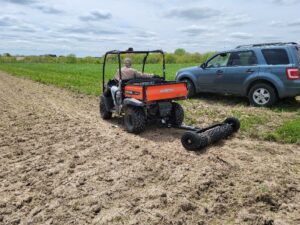
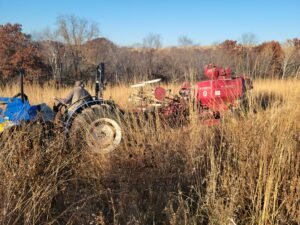
COMPONENT ONE : COVER CROPS AND PRAIRIE STRIPS FOR SOIL QUALITY AND GRAZING
Jeremy Nagel Farm, Soldiers Grove, WI
Demonstration of cover crop seeding, grazing and management. Establishment and assessment of prairie strip soil benefits.
Jeremy Nagel planted 7-acres of a brassica, clover, warm season mix as an annual in early June 2021. Directly following the planting there were two weeks of dry weather resulting in only minimal growth in the early season. He was able to graze it for two days in mid-July, followed by 30 days rest. Then grazed it for a week in mid-August. He applied a herbicide late season to kill off the clover, as the following spring (2022) he planned to rotate the field into corn.
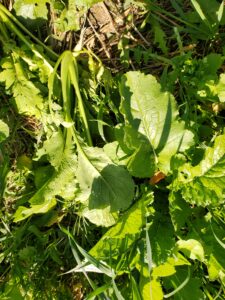
Prairie Strip Establishment
1 acre was planted by VSN staff in November 2020. Nagels mowed planting several times.
Water infiltration test was 2.5x higher in grassed waterway than soybeans. Increasing the areas of perennial cover should help improve water infiltration rates.
COMPONENT TWO: COVER CROP SEEDING, MANAGEMENT AND GRAZING
Brad Robson Farm, Viroqua, WI
Demonstration of cover crop seeding, management and grazing.
Cover Crop Establishment 2021
On July 23, 2021 a drone inter-seeded red clover into 20-acres of soybeans. The clover germinated quickly and grew for about two weeks before terminating. We speculated that it was due to residual chemicals in the field.
Cover Crop Establishment 2022
Soybeans were planted in both 15” and 30” row spacing to learn if there would be any better establishment based on spacing, when inter-seeding a legume plant during the soybean growing season. Red Clover was inter-seeded at a rate of 10 lbs./acre into the growing soybean crop at V2 growth stage. In the spring of 2023, the corn would be planted green to allow the clover to grow as late and tall as possible to build biomass and a ground cover mat for weed suppression, nutrient management and erosion control. Unfortunately, due to some weed issues the soybean crop had to be resprayed which in turn eliminated the red clover stand.
A key take away from this project, as with others we have worked on, is fine tuning the chemical and fertilizer systems to better support the use of creative cover crop usage in our specific geographic and temperate area.
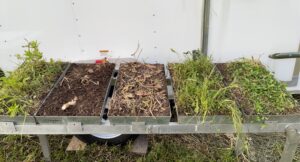
Overall Lessons Learned:
Adequate pre-planning for any projects needs to be completed. There are so many variables in agriculture beyond our control, however many of them can be prepared or managed for by including variations in the project and an inclusive planning process. As we learned over three years, on-farm experiments can provide valuable information to improve our farming practices whether it’s to improve our environmental footprint, or enhance profitability. One of the key lessons from those experiments is they need to be manageable in size, but relatable in practice and practicality of real time and localized farming practices.
Future experiments for consideration are to more closely study a herbicide and fertility program relative to specific timing in plant maturity in corn and soybean cash crop rotations. The herbicide program offers the greatest margin of opportunity to be creative in utilizing covers successfully at varying times of the year. We have also found that with incorrect herbicide pairings, or residual, it has likely caused cover crop failure; which we hope to research to avoid. It is tough to manage the weed control properly but allow yourself the ability to inter-seed cover crops in an actively growing cash crop. When also considering a strategic fertility program, it may allow for inter-seeding cover crops in a corn crop specifically with no added passes or increased expense. Hypothesizing that fertility is returned exponentially to the following crops for multiple years due to better soil health measures.
We have a substantial opportunity to research cover crop inter-seeding programs that can work into corn and soybeans in our northern environment. There is a very short growing season for covers to become established to the point of success after cash grain harvest of corn and soybeans. It is our objective to create educational research and demonstration plots that provide economically sustainable conservation agriculture. In one of the most erodible geographical areas of the United States, our responsibility to the land and to the farmer is to manage erosion, increase infiltration, increase nutrient binding, and increase farmer profitability; and we believe that cover crops are one tool to help support that goal. Working to make covers functional , profitable, and fit into a window of practical application for the farmer is the objective for that goal.
The SARE program has provided opportunities to research and demonstrate ideas and experiments locally that farmers and landowners may not have the opportunity or interest in conducting on their own. Having a organization providing guidance and SARE’s financial commitment to the program is vital to the future of experimenting and demonstrating real on-farm practices to grow a healthy and sustainable future for our local farmers and landowners.
COMPONENT THREE: BIRD FRIENDLY HAYING AND GRAZING
Jim Munsch, Deer Run Farm, Coon Valley, WI
Jason Vidas, Bird Friendly Wisconsin, La Farge, WI (VSN Consultant)
Test and establish verification standards and economic impacts for bird-friendly grazing and hay production, including haying and grazing management, bird surveys and nest refuge paddock guidelines.
Objectives Achieved
Verification standards were established for bird-friendly grazing and hay production with four additional producers are beginning to adopt these practices. Further impact will be measured by value-added bird friendly beef and hay education, marketing and sales. Bird survey point counts at five locations were completed weekly for 8-weeks in Summer 2020 and 2021. As a result of this project success, several regional partner organizations have initiated bird friendly farm-related projects in collaboration with VSN. A bird friendly farming website was also developed: https://birdfriendlyfarming.org/
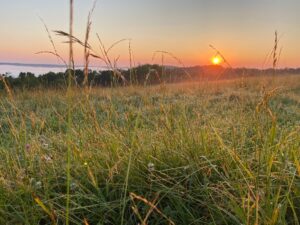
Summary of 2020 breeding bird survey results:
- On the rotationally grazed pastures, we noticed many birds - Bobolink, Eastern Meadowlark, Savannah Sparrow, and Dickcissel utilizing the ground to attempt breeding before any grazing occurred. Once grazing moved into an area, the breeding cycle of all birds was disrupted, with the exception of Savannah Sparrows, which seemed to continue in certain areas even after grazing occurred. We did note that Eastern Meadowlark was noted carrying food on June 17th in a pasture that hadn't been grazed yet, so that species may see nesting success in some late-grazed paddocks owing to its early start to breeding.
- On the breeding refuge, we noted likely breeding Bobolinks (at least two pair), Eastern Meadowlarks (at least one pair) , and Field Sparrow (likely one pair). We did not attempt to locate nests. We did notice Bobolinks carrying food, so likely breeding success confirmed.
- On the conventional hay fields, all breeding was disrupted upon hay harvest.
- On the bird-friendly hay (late cut) - There was likely some breeding success of Eastern Meadowlark and Bobolink and Field Sparrows. Owing to the shape of the late-cut hay (a long rectangle), there was noted some disturbance and contraction of signs of breeding after the hay directly adjacent was harvested, but hard to confirm this with 10 minute surveys.
It is fair to say that the breeding refuge and the late-cut hay were both more successful in allowing grassland birds to breed than the other treatments.
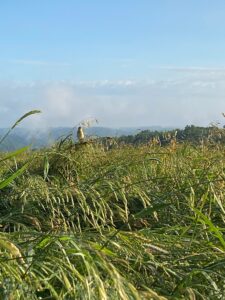
2021 Bird Survey Results
The Munsch Farm was surveyed for breeding bird activity from June 3, 2021 through July 21, 2021 for a total of eight surveys. The purpose of these surveys was to observe breeding bird activity on the property and provide feedback on bird use of the managed rotational grazing areas and the reserve. A total of six survey locations were designated on the property: one in a managed rotational grazing area set away from the reserve, two in managed rotational grazing areas adjacent to the reserve, one within the reserve itself, one in a field hayed prior to the start of the surveys, and one in a field hayed late in the survey period.
Observation Overview:
Managed Rotational Grazing Set Away from the Reserve (Site 1): This survey site was along the edge of two separated rotational grazing paddocks and had primarily forest and edge bird species present. The most frequently heard species here included: black-capped chickadees, eastern wood-pewees, house wrens, indigo buntings, and a mixture of woodpecker species. On occasion, a dickcissel or savanna sparrow would be heard, but not with frequency enough to indicate breeding activity.
Managed Rotational Grazing Adjacent to the Reserve (Sites 2 & 3): These two sites were very similar in bird presence, with Site 2 having a higher density of bird species and individuals (anecdotally). These two sites included high number of grassland birds within the 100m diameter area, including bobolinks, dickcissels, sedge wrens, savanna sparrows, and a small number of eastern meadowlarks. In addition to these priority grassland species, there were also significant numbers of red-winged blackbirds, a handful of field sparrows, and the mixture of woodland and edge species listed for Site 1. These birds remained in the area the entirety of the season and there was significant breeding bird behavior (conspecific territory defense, aggravated circling during my presence, and food carrying) from bobolinks, dickcissels, and savanna sparrows. These species remained at their territories before, during, and after grazing occurred. On occasion, they were also seen using the refuge area, and most breeding behavior was witnessed near the border between these sites and the refuge.
Within the Reserve (Site 4): Within the refuge there were dense numbers of bobolinks and a smaller number of savanna sparrows and eastern meadowlarks. The eastern meadowlarks and savanna sparrows seemed to be around the edge while the bobolinks were more centrally located. These species remained in this area during the entirety of the breeding season. The bobolinks displayed significant territory defense and food carrying and on one occasion a savanna sparrow was flushed from an assumed nest. After the main breeding season was over, the bobolinks remained in this area and began grouping up. This would signify, anecdotally, that this refuge was important not just for breeding but for their fledging and pre-migration seasons.
Field Hayed Prior to Surveys Beginning (Site 5): This field was hayed in the last week of May/first week of June prior to the surveys beginning. The vegetation stood at approximately 3-5 inches at the start of the surveys and was knee height during the last survey. There was very little to no activity within the 100m diameter of the survey point. The most audible/visible birds included blue jays, house wrens, black-capped chickadees, barn swallows, and a mixture of other woodland/edge species. On occasion, an eastern meadowlark or two or a savanna sparrow were heard at the northern edge of this field where the Reserve began, or an eastern meadowlark was on the southern edge of the field perched on a fence. Last year, when this was the Reserve, a number of bobolinks were present for the duration of the summer.
Field Hayed Late in the Season (Site 6): This field was standing grass during most of the breeding season and was hayed in sections during mid- to late-July. Before the haying, there were multiple eastern meadowlarks, savanna sparrows, and a couple of bobolinks in this area. All of which were showing signs of territory defense. After haying, the area had fewer bobolinks, and the eastern meadowlarks and savanna sparrows quieted down but were still in the area. Other species present included indigo buntings, common yellowthroats, and field sparrows.
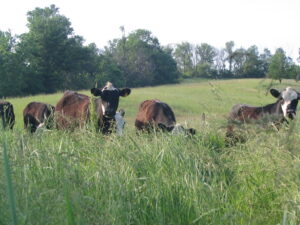
2021 YIELD AND FINANCIAL IMPACT
This is a report on the yield and financial impact of following the WI Bird-Friendly Beef Certification Protocols. The main thrust of this system is setting aside 15% of the grazing acreage to make a “refuge” that will not be grazed or hayed from May 1st – July 15th, which will allow grassland birds to successfully reproduce. My refuge was 7.6 acres of our 50 acre pasture system used for our cow/calf operation. It was not grazed until July19 thru July 24. The refuge area was located central to the whole pasture system so that non-refuge paddocks surrounded it and separated it from wooded land.
Protocol for measuring yield was to take clippings from established areas (4 sq ft) in five locations selected by a consistent sampling pattern in a paddock the day cattle were introduced to it. Clippings were taken to 4 inches of residual. Samples were taken from a baseline paddock adjacent to the refuge on five grazing events from May 10 to Oct 10. Management of the baseline paddock was consistent to management across the majority of the whole system. The refuge was grazed the first time on July 19 and then two additional times through October 11 - each time on the day following the baseline paddock. All clippings were dried to 0% moisture to determine tons of dry matter yield (TDM/a.)
There was a 9.1% yield reduction in the refuge area vs. yield in the adjacent, baseline paddock. Over the whole refuge area this was estimated as 0.75 TDM. Yields throughout the pasture system were suppressed this year due to early and persistent drought and unusually cold weather in April and May. Across multiple years our average forage is 5,000#/a (DM basis) or 2.5 TDM/a. Therefore, in a normal year the total reduction in the refuge would have been 1.73 TDM (9% reduction on 2.5 TDM/a over 7.6 acres in the refuge.)
Samples that were taken to determine yield were not sent for nutrient analysis but it was obvious that the quality of forage was poor at the time of the first grazing of the refuge. Calves were 6-weeks old on average at the time of the first refuge grazing so milk production by the cows was high; poor quality forage probably suppressed milk production during the days that the cows were grazing the mature forage. They grazed mature refuge for five days. Furthermore, palatability was reduced as indicated by the relatively high forage refusal rate. This was not measured but only observed after grazing. Therefore, while DM reduction was measured as above, forage intake was probably reduced to a greater extent.
An interesting positive outcome for pasture health from refuge management was increased grass density. Dominant species in these pastures are meadow fescue, smooth brome grass, timothy and blue grass. Meadow fescue had viable seeds by the first grazing date in the refuge; there was an obvious increase in number of plants late in the year.
If you consider that the shortfall in a normal year would be made up with harvested hay @$100/TDM, it means the increased cost of the refuge system was $173 for establishing a bird-breeding refuge. We believe the total cost might be slightly greater due to reduced DM intake rate and reduced forage quality but there also may be benefits to using this system beyond natural re-seeding.
To summarize, the external costs to a farmer to follow the certification are minimal when you consider that being certified would allow a farmer to market their beef as Certified WI Bird-Friendly Beef, which will likely allow a producer to get a higher price and increased demand for their beef.
Bird-Friendly grazing and haying practices continued in 2022 and will be maintained for the future as markets and outreach continue to be developed.
COMPONENT FOUR: PRAIRIE STRIPS FOR SOIL QUALITY AND BIODIVERSITY
Dave Van Dyke Farm, Viroqua, WI
Prairie strip planting, water infiltration, soil health and biodiversity (pollinator) data collected to demonstrate the effectiveness of the adaption of the ISU STRIPS model to SW Wisconsin.
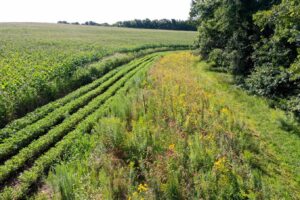
Prairie STRIP Establishment
VSN staff planted 1.6 acres of STRIPS on Dave Van Dyke and his neighbor’s property. Dave mowed the strip consistently and performed mechanical weed removal. Due to excellent week control before and after planting, this planting developed near perfectly and featured an ideal selection of native species, rare for a Year 1 planting. In 2021 and 2022, 1.5 additional acres were planted on the Van Dyke farm, also with excellent results due to weed control and careful maintenance.
Water Infiltration
VSN staff conducted water infiltration tests at Dave Van Dyke’s established prairie STRIP (two locations) (corn field and STRIP). Preliminary results are summarized here: Van Dyke Research Data and Pollinator Data 09132020 (1)
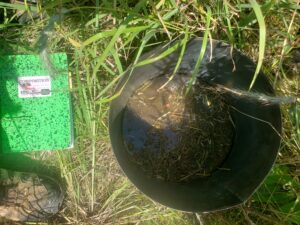
Final results are summarized in this graph:
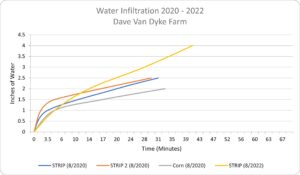
This data shows two sample sites in the STRIP in August 2020 (blue and orange, two sites were chosen because the site is sloped and we wanted to see if the slope significantly impacted our infiltration measurement); corn on that same data; and the STRIP again in 2022. Corn data was taken in 2022 as well, but was dramatically inconsistent, enough to say there must have been a problem with the sampling. It was too late in the season by the time this was realized to re-sample the corn in 2022.
The data does demonstrate that the STRIP is increasing its ability to infiltrate water, and that it is significantly better than corn. This is supported by the impacts observed in the field – the original driver for this STRIP was to reduce erosion in the field bottom caused by rapid rain runoff, and this is erosion is no longer happening with the mature STRIP in place!
Soil Quality Assessment
VSN staff conducted soil sampling at Dave Van Dyke’s farm (three locations, second sampling with previous data from 2018 at same sites). Soil samples were sent to Midwest Labs to get the ‘Haney Test’ and to the UW labs for a traditional soil test on the same grab samples. Preliminary results are summarized here: Van Dyke Research Data and Pollinator Data 09132020 (1)
Final results are summarized in these graphs:
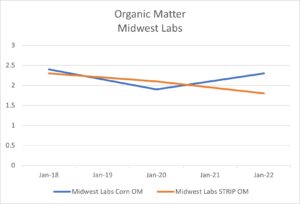
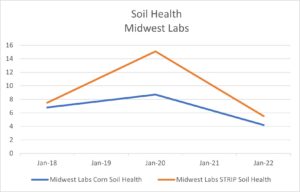
We can’t explain the reason why the organic matter of the STRIP would be decreasing over the four year period, nor the significant changes in the soil health calculation. It is promising at least that the trends for the soil health are consistent between the two fields though. We plan to continue this data gathering going forward which will hopefully shed more light on this data. SARE was key for the data gathering in 2020 and 2022.
Pollinator Survey
VSN staff conducted a pollinator survey at Dave Van Dyke’s prairie strip with prairie expert Dr. John Delaney in September 2020. Results showed 13 insect groups and 50 individuals. We also noted floral associations, which insect types were on which blooming plant. Results are detailed here: Van Dyke Research Data and Pollinator Data 09132020 (1)
Pollinator survey results are also summarized in this graph:
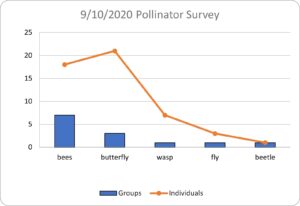
Educational & Outreach Activities
Participation Summary:
COMPONENT TWO: COVER CROP SEEDING, MANAGEMENT AND GRAZING
Brad Robson Farm, Viroqua, WI
FIELD DAYS
Two Farm Field Days were held in 2020. The first field day featured inter-seeding cover crops on 30 and 45 inch rows. The second field day featured cover crop identification, consultations and economics, soil pit, corn tissue sampling and late season cover crop grazing.
One Farm Field Day was held in September, 2021 and featured drone cover crop seeding demonstration, soil pits, rainfall simulator, and cover crop consultations.
There were approximately 20 attendees at each field day.
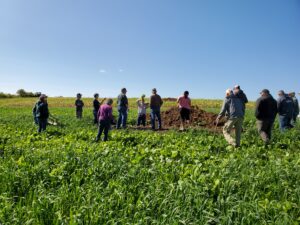
COMPONENT THREE: BIRD FRIENDLY HAYING AND GRAZING
Jim Munsch, Deer Run Farm, Coon Valley, WI
Jason Vidas, Bird Friendly Wisconsin, La Farge, WI (VSN Consultant)
Field Days
One field day was held at the Munsch farm in July 2022. Approximately 35 farmers and other community watershed council members attended and learned about bird-friendly grazing and haying practices.
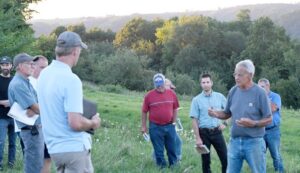
2020 CONSUMER OUTREACH MATERIALS AND WEBSITE
(Used for November 2020 Bird Friendly meal catered for a VSN member presentation)
Valley Stewardship Network’s Bird Friendly Farming Initiative made good progress this year as we continue to pursue our goal of creating a consumer market for Bird-Friendly Beef and Bird-Friendly Hay in Wisconsin.
Thanks to a SARE grant, we started testing out our ideas about Bird-Friendly Beef on an actual farm – Jim Munsch’s Deer Run Farm near Coon Valley. Our plan for Bird-Friendly Beef centers around the farmer creating a grassland bird refuge in the grazing paddocks that won’t be grazed from May 1 – July 15th. This refuge will make up between 10-20% of the grazed land and needs to be contiguous. This year, Jim set aside around 10% of his grazing area for the refuge.
On Jim’s farm, we did a breeding bird survey for 8 weeks throughout the grazing paddocks (both the paddocks utilized as well as the refuge paddocks) and his hay ground. The data still need further analyzing, but I can report that the refuge was a success for breeding grassland birds such as Bobolink and Eastern Meadowlark.
We are still working out the details, but we hope to be able to offer Bird-Friendly beef from Jim Munsch’s farm to VSN members.
On the Bird-Friendly Hay side of things, we are also working with Jim Munsch to produce a guide for hay producers. Bird-Friendly Hay is basically hay that is first harvested after July 15th. Over the years, Jim has experimented with different seed mixes and has found a mix that allows hay to be harvested in a Bird-Friendly way and still have a high relative feed value. Look for this guide to be ready by the end of winter.
Changes to more Bird-Friendly ways of farming will ultimately be driven by the consumer. Our role here at VSN is to try to bring these products to market and educate the consumer about the real positive differences they can make to our endangered grassland birds. After that, it is up to the marketplace to decide whether these products have value for the consumer.
Do you purchase hay and would you like to find a Bird-Friendly version that meets your needs? Do you eat grass-fed beef and be willing to pay a little extra for Bird-Friendly beef? If so, we want to hear from you (and your friends). Having a list of real people willing to spend real dollars is the best leverage we can have to encouraging farmers to give these practices a place on the farm.
If you are interested in purchasing Bird-Friendly beef or hay or learning more, please check out our website: https://birdfriendlyfarming.org/ or contact me at Jason@Birdfriendlyfarming.org
COMPONENT FOUR: PRAIRIE STRIPS FOR SOIL QUALITY AND BIODIVERSITY
Dave Van Dyke Farm, Viroqua, WI
August 2021 FIELD DAY
VSN staff worked with Dave Van Dyke to coordinate, promote and host a STRIP Field Day at the Van Dyke farm in August 2021. There was an excellent article in the Crawford Independent on STRIPS and the Field Day: Van Dyke Prairie STRIP Article 8-21
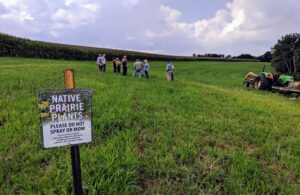
May and October 2022 FIELD DAYS
VSN staff assisted Dave Van Dyke with two field days in 2022. Total attendance was 38 and included farmers and ag professionals from across the state.
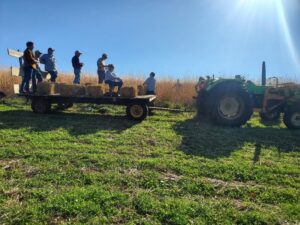
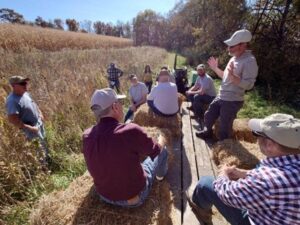
Also, an essay was written about native prairie STRIPS, and was read on WDRT radio, 91.9FM. It is here, episode #61: https://www.wdrt.org/podcasts/natural-wonders/
VSN staff gave five educational presentations at VSN member meetings, watershed council meetings and professional workshops.
Learning Outcomes
Robson Lessons learned from the SARE Project:
Adequate pre-planning for any projects needs to be completed. There are so many variables in agriculture beyond our control, however many of them can be prepared or managed for by including variations in the project and an inclusive planning process. As we learned over three years, on-farm experiments can provide valuable information to improve our farming practices whether it’s to improve our environmental footprint, or enhance profitability. One of the key lessons from those experiments is they need to be manageable in size, but relatable in practice and practicality of real time and localized farming practices.
Future experiments for consideration are to more closely study a herbicide and fertility program relative to specific timing in plant maturity in corn and soybean cash crop rotations. The herbicide program offers the greatest margin of opportunity to be creative in utilizing covers successfully at varying times of the year. We have also found that with incorrect herbicide pairings, or residual, it has likely caused cover crop failure; which we hope to research to avoid. It is tough to manage the weed control properly but allow yourself the ability to inter-seed cover crops in an actively growing cash crop. When also considering a strategic fertility program, it may allow for interseeding cover crops in a corn crop specifically with no added passes or increased expense. Hypothesizing that fertility is returned exponentially to the following crops for multiple years due to better soil health measures.
We have a substantial opportunity to research cover crop interseeding programs that can work into corn and soybeans in our northern environment. There is a very short growing season for covers to become established to the point of success after cash grain harvest of corn and soybeans. It is our objective to create educational research and demonstration plots that provide economically sustainable conservation agriculture. In one of the most erodible geographical areas of the United States, our responsibility to the land and to the farmer is to manage erosion, increase infiltration, increase nutrient binding, and increase farmer profitability; and we believe that cover crops are one tool to help support that goal. Working to make covers functional , profitable, and fit into a window of practical application for the farmer is the objective for that goal.
The SARE program has provided opportunities to research and demonstrate ideas and experiments locally that farmers and landowners may not have the opportunity or interest in conducting on their own. Having a organization providing guidance and SARE’s financial commitment to the program is vital to the future of experimenting and demonstrating real on-farm practices to grow a healthy and sustainable future for our local farmers and landowners.Verification standards were established for bird-friendly grazing and hay production with four additional producers are beginning to adopt these practices. Further impact will be measured by value-added bird friendly beef and hay education, marketing and sales. Bird survey point counts at five locations were completed weekly for 8-weeks in Summer 2020 and 2021. As a result of this project success, several regional partner organizations have initiated bird friendly farm-related projects in collaboration with VSN. An interesting positive outcome for pasture health from refuge management was increased grass density. Dominant species in these pastures are meadow fescue, smooth brome grass, timothy and blue grass. Meadow fescue had viable seeds by the first grazing date in the refuge; there was an obvious increase in number of plants late in the year.
From 2018 to 2022 we visited 61 landowners to see if STRIPS would fit their objectives for their land. Of those, we planted on 19 of those properties with 30 different fields. Of the 30 different fields, 18 of those were during the SARE grant period. The success of those plantings living is between 60-90%, depending on how well some just-planted STRIPS turn out (tentatively all of the recent fields look good). SARE funding through the grant period allowed us to make 55 of the 61 visits!
Project Outcomes
All four components of the project have been well received by farmers and rural landowners, and especially members of five watershed councils in our area, who have come together for the benefits of farmer-led learning. Through on-farm research and outreach, this project has helped prove the agricultural and ecological resiliency benefits of the pioneering practices of cover crops, prairie strips and grassland bird refuges in grazing systems. These local successes have attracted the attention and support of regional and state-level partner organizations that are likely to help take these practices to the next level by providing support and cost share for large numbers of farmers.